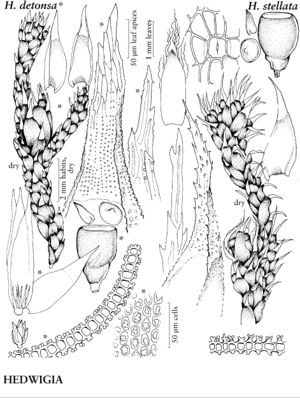Difference between revisions of "Hedwigia detonsa"
Nova Hedwigia 62: 368. 1996.
FNA>Volume Importer |
FNA>Volume Importer |
||
| Line 33: | Line 33: | ||
|elevation=low to moderate elevations (200-1500 m) | |elevation=low to moderate elevations (200-1500 m) | ||
|distribution=Calif. | |distribution=Calif. | ||
| − | |discussion=<p>Unlike the irregular papillae of Hedwigia ciliata and H. stellata, those of H. detonsa as seen in cross section are nearly identical in regularity of form, moderately stalked and evenly branched. Current studies suggest the species is endemic to California, but it may also be expected in Baja California (W. R. Buck and D. H. Norris 1996). These authors find H. detonsa characteristic of river canyons and open, forested lands, more inland than H. stellata, and avoiding grasslands and savannas.</p><!-- | + | |discussion=<p>Unlike the irregular papillae of <i>Hedwigia ciliata</i> and <i>H. stellata</i>, those of <i>H. detonsa</i> as seen in cross section are nearly identical in regularity of form, moderately stalked and evenly branched. Current studies suggest the species is endemic to California, but it may also be expected in Baja California (W. R. Buck and D. H. Norris 1996). These authors find <i>H. detonsa</i> characteristic of river canyons and open, forested lands, more inland than <i>H. stellata</i>, and avoiding grasslands and savannas.</p><!-- |
| − | --><p>Hedwigia nivalis (Müller Hal.) Mitten</p><!-- | + | --><p><i>Hedwigia</i> nivalis (Müller Hal.) Mitten</p><!-- |
| − | --><p>As noted above, the occurrence of Hedwigia nivalis in the flora area was discussed by W. R. Buck and D. H. Norris (1996), but without definitive conclusion.</p><!-- | + | --><p>As noted above, the occurrence of <i>Hedwigia</i> nivalis in the flora area was discussed by W. R. Buck and D. H. Norris (1996), but without definitive conclusion.</p><!-- |
| − | --><p>Hedwigia ciliata var. leucophaea Bruch & Schimper</p><!-- | + | --><p><i>Hedwigia ciliata</i> var. leucophaea Bruch & Schimper</p><!-- |
| − | --><p>Only the typical variety of Hedwigia ciliata was accepted for the flora of North America by L. E. Anderson et al. (1990). Variety leucophaea is an established European taxon accepted as a northern variant of H. ciliata by L. Hedenäs (1994), but it was not reported or recognized in several northern or circumboreal floras, such as that of Canada (R. R. Ireland et al. 1987).</p> | + | --><p>Only the typical variety of <i>Hedwigia ciliata</i> was accepted for the flora of North America by L. E. Anderson et al. (1990). Variety leucophaea is an established European taxon accepted as a northern variant of <i>H. ciliata</i> by L. Hedenäs (1994), but it was not reported or recognized in several northern or circumboreal floras, such as that of Canada (R. R. Ireland et al. 1987).</p> |
|tables= | |tables= | ||
|references= | |references= | ||
| Line 61: | Line 61: | ||
|publication year=1996 | |publication year=1996 | ||
|special status=Endemic;Selected by author to be illustrated | |special status=Endemic;Selected by author to be illustrated | ||
| − | |source xml=https://jpend@bitbucket.org/aafc-mbb/fna-data-curation.git/src/ | + | |source xml=https://jpend@bitbucket.org/aafc-mbb/fna-data-curation.git/src/8f726806613d60c220dc4493de13607dd3150896/coarse_grained_fna_xml/V28/V28_135.xml |
|genus=Hedwigia | |genus=Hedwigia | ||
|species=Hedwigia detonsa | |species=Hedwigia detonsa | ||
Revision as of 17:03, 18 September 2019
Leaves 2–2.5 mm; margins broadly or narrowly recurved in basal 1/4 or plane on one or both sides, erect to incurved in acumen, entire in apex; apex erect when dry, broad, hyaline, acumen broad-based, 1/5–2/5(–1/2) leaf length, channeled to tubular, extreme apex flat or sometimes twisted; medial and distal laminal cells with papillae 1 (or 2), large, stalked, strongly, regularly branched, branches usually of equal lengths, especially on abaxial surface; laminal cells in hyaline area with papillae low, simple at base, in longitudinal lines on cell lumina; apical cell long-linear, sharply pointed, (80–)110–125(–150) µm, multipapillose with papillae minute, simple, scattered on lumina and margins, or sometimes smooth. Perichaetia with leaves broadly channeled to involute, margins entire. Vaginula sparsely pilose. Calyptra naked to sparsely pilose.
Phenology: Capsules mature spring.
Habitat: River canyons, open forested lands, dry or moist acidic rock, sandstone, boulders and cliff faces near creeks, open, diffusely lighted mixed forests of Aesculus californica, Calocedrus, Pinus coulteri, Quercus chrysolepis, Torreya, and Umbellularia
Elevation: low to moderate elevations (200-1500 m)
Discussion
Unlike the irregular papillae of Hedwigia ciliata and H. stellata, those of H. detonsa as seen in cross section are nearly identical in regularity of form, moderately stalked and evenly branched. Current studies suggest the species is endemic to California, but it may also be expected in Baja California (W. R. Buck and D. H. Norris 1996). These authors find H. detonsa characteristic of river canyons and open, forested lands, more inland than H. stellata, and avoiding grasslands and savannas.
Hedwigia nivalis (Müller Hal.) Mitten
As noted above, the occurrence of Hedwigia nivalis in the flora area was discussed by W. R. Buck and D. H. Norris (1996), but without definitive conclusion.
Hedwigia ciliata var. leucophaea Bruch & Schimper
Only the typical variety of Hedwigia ciliata was accepted for the flora of North America by L. E. Anderson et al. (1990). Variety leucophaea is an established European taxon accepted as a northern variant of H. ciliata by L. Hedenäs (1994), but it was not reported or recognized in several northern or circumboreal floras, such as that of Canada (R. R. Ireland et al. 1987).
Selected References
None.

